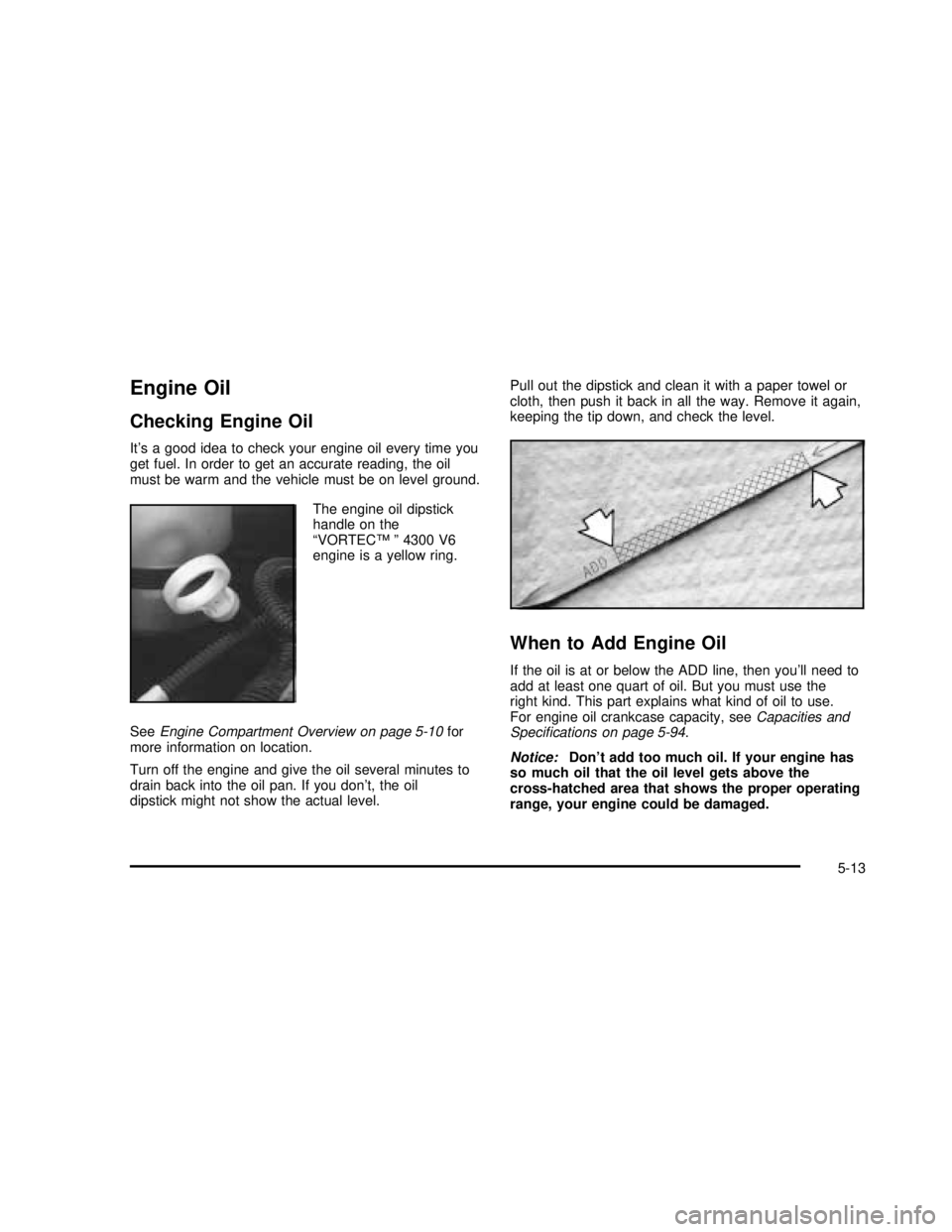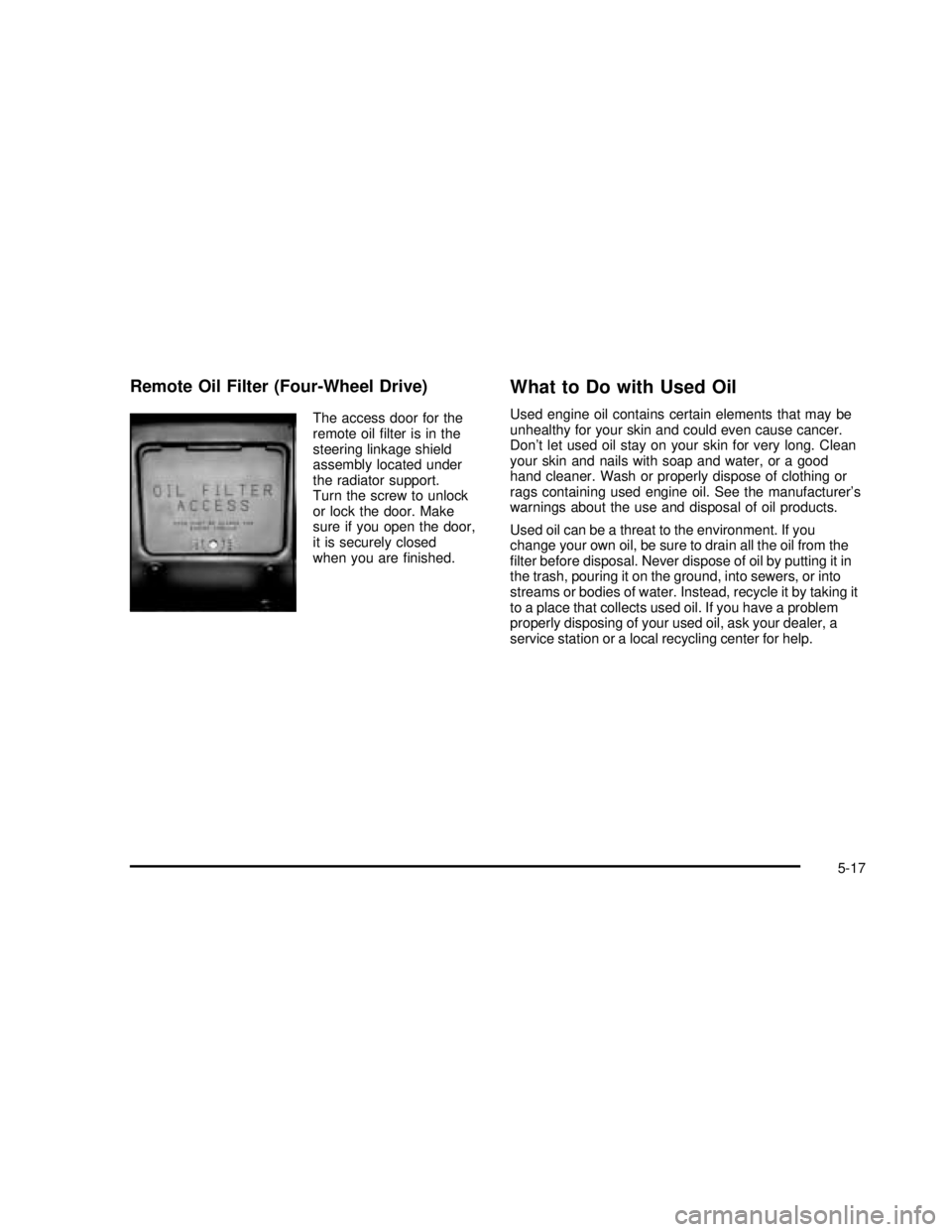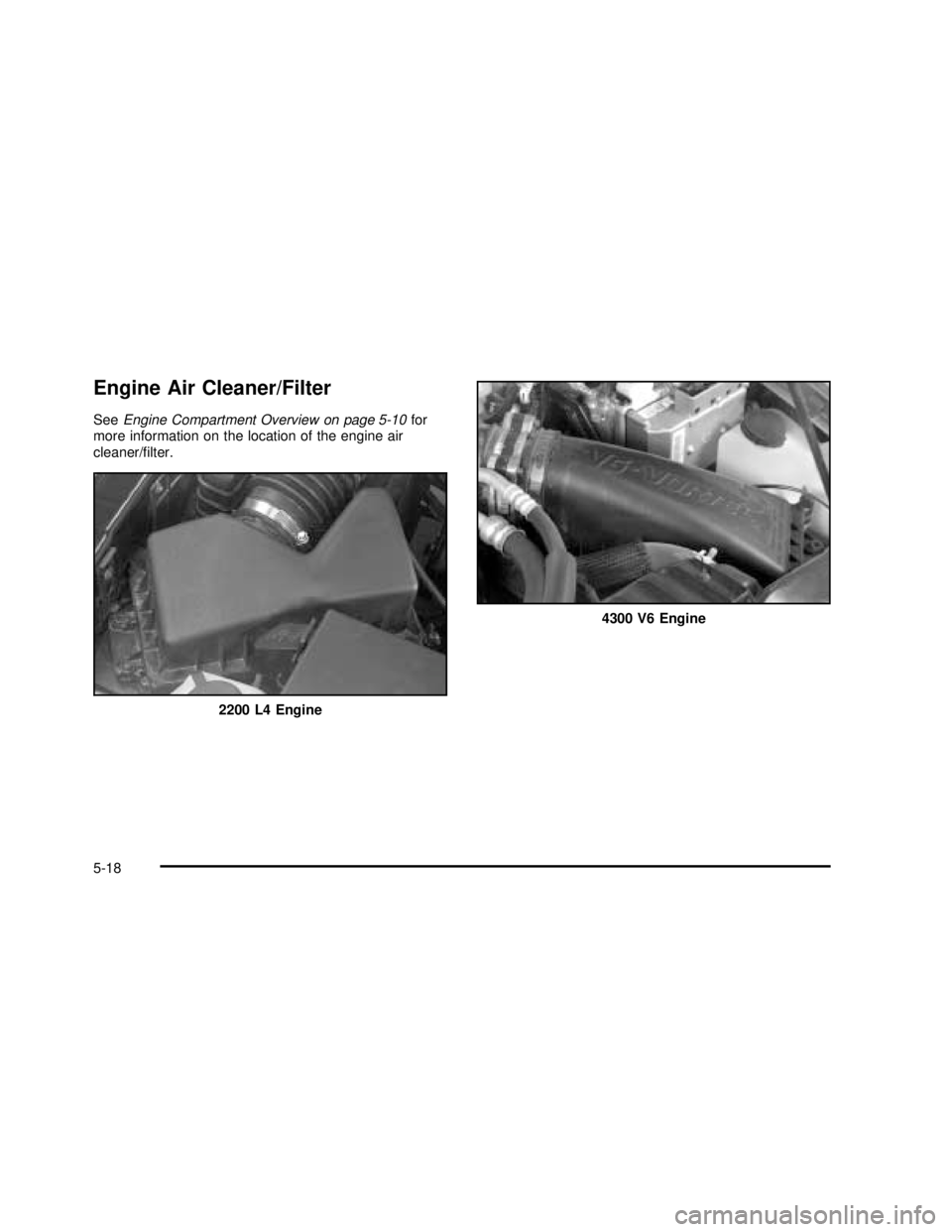GMC SONOMA 2003 Owner's Manual
Manufacturer: GMC, Model Year: 2003, Model line: SONOMA, Model: GMC SONOMA 2003Pages: 424, PDF Size: 2.45 MB
Page 271 of 424

Engine Oil
Checking Engine Oil
It’s a good idea to check your engine oil every time you
get fuel. In order to get an accurate reading, the oil
must be warm and the vehicle must be on level ground.
The engine oil dipstick
handle on the
“VORTEC™”4300 V6
engine is a yellow ring.
SeeEngine Compartment Overview on page 5-10for
more information on location.
Turn off the engine and give the oil several minutes to
drain back into the oil pan. If you don’t, the oil
dipstick might not show the actual level.Pull out the dipstick and clean it with a paper towel or
cloth, then push it back in all the way. Remove it again,
keeping the tip down, and check the level.
When to Add Engine Oil
If the oil is at or below the ADD line, then you’ll need to
add at least one quart of oil. But you must use the
right kind. This part explains what kind of oil to use.
For engine oil crankcase capacity, seeCapacities and
Specifications on page 5-94.
Notice:Don’t add too much oil. If your engine has
so much oil that the oil level gets above the
cross-hatched area that shows the proper operating
range, your engine could be damaged.
5-13
2003 - Sonoma OM
Page 272 of 424

If you have the 2200 L4
engine, the engine oilfill
cap is located in the rear
of the engine compartment
on the passenger’s side
of the vehicle. If you have
the 4300 V6 engine, it
is located in the rear of the
engine compartment on
the driver’s side of
the vehicle.
Be sure tofill it enough to put the level somewhere in
the proper operating range. Push the dipstick all the way
back in when you’re through.What Kind of Engine Oil to Use
Oils recommended for your vehicle can be identified by
looking for the starburst symbol.
This symbol indicates that the oil has been certified by
the American Petroleum Institute (API). Do not use
any oil which does not carry this starburst symbol.
If you choose to perform
the engine oil change
service yourself, be sure
the oil you use has the
starburst symbol on the
front of the oil container.
If you have your oil
changed for you, be sure
the oil put into your engine
is American Petroleum
Institute certified for
gasoline engines.
You should also use the proper viscosity oil for your
vehicle, as shown in the viscosity chart.
5-14
2003 - Sonoma OM
Page 273 of 424

As in the chart shown previously, SAE 5W-30 is the
only viscosity grade recommended for your vehicle.
You should look for and use only oils which have the
API Starburst symbol and which are also identified
as SAE 5W-30. If you cannotfind such SAE 5W-30 oils,
you can use an SAE 10W-30 oil which has the API
Starburst symbol, if it’s going to be 0°F(−18°C)
or above. Do not use other viscosity grade oils, such as
SAE 10W-40 or SAE 20W-50 under any conditions.
Notice:Use only engine oil with the American
Petroleum Institute Certi�ed For Gasoline Engines
starburst symbol. Failure to use the recommended
oil can result in engine damage not covered by
your warranty.
GM Goodwrench
®oil meets all the requirements for
your vehicle.
If you are in an area of extreme cold, where the
temperature falls below−20°F(−29°C),itis
recommended that you use either an SAE 5W-30
synthetic oil or an SAE 0W-30 oil. Both will provide
easier cold starting and better protection for your engine
at extremely low temperatures.
5-15
2003 - Sonoma OM
Page 274 of 424

Engine Oil Additives
Don’t add anything to your oil. The recommended oils
with the starburst symbol are all you will need for
good performance and engine protection.
When to Change Engine Oil
If any one of these is true for you, use the short trip/city
maintenance schedule:
•Most trips are less than 5 miles (8 km). This is
particularly important when outside temperatures
are below freezing.
•Most trips include extensive idling (such as
frequent driving in stop-and-go traffic).
•You frequently tow a trailer or use a carrier on
top of your vehicle.
•The vehicle is used for delivery service, police,
taxi or other commercial application.Driving under these conditions causes engine oil to
break down sooner. If any one of these is true for your
vehicle, then you need to change your oil andfilter
every 3,000 miles (5 000 km) or 3 months—whichever
occursfirst.
If none of them is true, use the long trip/highway
maintenance schedule. Change the oil andfilter every
7,500 miles (12 500 km) or 12 months—whichever
occursfirst. Driving a vehicle with a fully warmed engine
under highway conditions will cause engine oil to
break down slower.
5-16
2003 - Sonoma OM
Page 275 of 424

Remote Oil Filter (Four-Wheel Drive)
The access door for the
remote oilfilter is in the
steering linkage shield
assembly located under
the radiator support.
Turn the screw to unlock
or lock the door. Make
sure if you open the door,
it is securely closed
when you arefinished.
What to Do with Used Oil
Used engine oil contains certain elements that may be
unhealthy for your skin and could even cause cancer.
Don’t let used oil stay on your skin for very long. Clean
your skin and nails with soap and water, or a good
hand cleaner. Wash or properly dispose of clothing or
rags containing used engine oil. See the manufacturer’s
warnings about the use and disposal of oil products.
Used oil can be a threat to the environment. If you
change your own oil, be sure to drain all the oil from the
filter before disposal. Never dispose of oil by putting it in
the trash, pouring it on the ground, into sewers, or into
streams or bodies of water. Instead, recycle it by taking it
to a place that collects used oil. If you have a problem
properly disposing of your used oil, ask your dealer, a
service station or a local recycling center for help.
5-17
2003 - Sonoma OM
Page 276 of 424

Engine Air Cleaner/Filter
SeeEngine Compartment Overview on page 5-10for
more information on the location of the engine air
cleaner/filter.
2200 L4 Engine
4300 V6 Engine
5-18
2003 - Sonoma OM
Page 277 of 424

When to Inspect the Engine Air
Cleaner/Filter
Inspect the air cleaner/filter every 15,000 miles
(25 000 km) and replace every 30,000 miles (50 000 km).
If you are driving in dusty/dirty conditions, inspect the
filter at each engine oil change.
How to Inspect the Engine Air
Cleaner/Filter
To remove either engine air cleaner/filter, do the
following:
1. Remove the fasteners that hold the cover on and
remove the cover
2. Lift out the engine air cleaner/filter, if needed.
3. Insert a new airfilter. SeeNormal Maintenance
Replacement Parts on page 5-96to determine
whichfilter to use.
4. Reinstall the engine air cleaner/filter cover.
Tighten the fasteners to hold the cover in place.
{CAUTION:
Operating the engine with the air cleaner/�lter
off can cause you or others to be burned. The
air cleaner not only cleans the air, it helps to
stop�ame if the engine back�res. If it isn’t there
and the engine back�res, you could be burned.
Don’t drive with it off, and be careful working on
the engine with the air cleaner/�lter off.
Notice:If the air cleaner/�lter is off, a back�re can
cause a damaging engine�re. And, dirt can
easily get into your engine, which will damage it.
Always have the air cleaner/�lter in place when
you’re driving.
5-19
2003 - Sonoma OM
Page 278 of 424

Automatic Transmission Fluid
When to Check and Change
A good time to check your automatic transmissionfluid
level is when the engine oil is changed.
Change both thefluid andfilter every 15,000 miles
(25 000 km) if the vehicle is mainly driven under one
or more of these conditions:
•In heavy city traffic where the outside temperature
regularly reaches 90°F (32°C) or higher.
•In hilly or mountainous terrain.
•When doing frequent trailer towing.
•Uses such as found in taxi, police or delivery
service.
If you do not use your vehicle under any of these
conditions, change thefluid andfilter every
50,000 miles (83 000 km).
SeePart A: Scheduled Maintenance Services
on page 6-4.
How to Check
Because this operation can be a little difficult, you may
choose to have this done at the dealership service
department.
If you do it yourself, be sure to follow all the instructions
here, or you could get a false reading on the dipstick.
Notice:Too much or too little�uid can damage
your transmission. Too much can mean that some
of the�uid could come out and fall on hot engine
part or exhaust system parts, starting a�re.
Too little�uid could cause the transmission to
overheat. Be sure to get an accurate reading if you
check your transmission�uid.
Wait at least 30 minutes before checking the
transmissionfluid level if you have been driving:
•When outside temperatures are above 90°F (32°C).
•At high speed for quite a while.
•In heavy traffic–especially in hot weather.
•While pulling a trailer.
To get the right reading, thefluid should be at normal
operating temperature, which is 180°Fto200°F
(82°Cto93°C)
5-20
2003 - Sonoma OM
Page 279 of 424

Get the vehicle warmed up by driving about 15 miles
(24 km) when outside temperatures are above
50°F (10°C).Ifit’s colder than 50°F (10°C), drive the
vehicle in THIRD (3) until the engine temperature gage
moves and then remains steady for 10 minutes.
A coldfluid check can be made after the vehicle has
been sitting for eight hours or more with the engine off,
but this is used only as a reference. Let the engine
run at idle forfive minutes if outside temperatures are
50°F (10°C) or more. If it’s colder than 50°F (10°C),
you may have to idle the engine longer. Should thefluid
level be low during this cold check, you must check
thefluid hot before addingfluid. Checking thefluid hot
will give you a more accurate reading of thefluid level.
Checking the Fluid Level
Prepare your vehicle as follows:
•Park your vehicle on a level place. Keep the engine
running.
•With the parking brake applied, place the shift lever
in PARK (P).
•With your foot on the brake pedal, move the shift
lever through each gear range, pausing for about
three seconds in each range. Then, position the shift
lever in PARK (P).
•Let the engine run at idle for three minutes or more.Then, without shutting off the engine, follow these steps:
The transmission
dipstick handle has
this symbol on it.
The transmission dipstick is located near the center of
the engine compartment. SeeEngine Compartment
Overview on page 5-10for more information on location.
1. Flip the handle up and then pull out the dipstick
and wipe it with a clean rag or paper towel.
2. Push it back in all the way, wait three seconds and
then pull it back out again.
5-21
2003 - Sonoma OM
Page 280 of 424

3. Check both sides of the dipstick, and read the lower
level. Thefluid level must be in the COLD area,
below the cross-hatched area, for a cold check or in
the HOT area or cross-hatched area for a hot
check.
4. If thefluid level is in the acceptable range, push the
dipstick back in all the way; thenflip the handle
down to lock the dipstick in place.
How to Add Fluid
Refer to the Maintenance Schedule to determine what
kind of transmissionfluid to use. SeePart D:
Recommended Fluids and Lubricants on page 6-33.
Addfluid only after checking the transmissionfluid while
it is hot. (A cold check is used only as a reference.)
If thefluid level is low, add only enough of the proper
fluid to bring the level up to the HOT area for a hot
check. It doesn’t take muchfluid, generally less
than one pint (0.5 L). Don’t overfill.
Notice:We recommend you use only�uid labeled
DEXRON
®-III, because�uid with that label is
made especially for your automatic transmission.
Damage caused by�uid other than DEXRON
®-III is
not covered by your new vehicle warranty.
•After addingfluid, recheck thefluid level as
described under“How to Check”earlier.
•When the correctfluid level is obtained, push the
dipstick back in all the way; thenflip the handle
down to lock the dipstick in place.
5-22
2003 - Sonoma OM